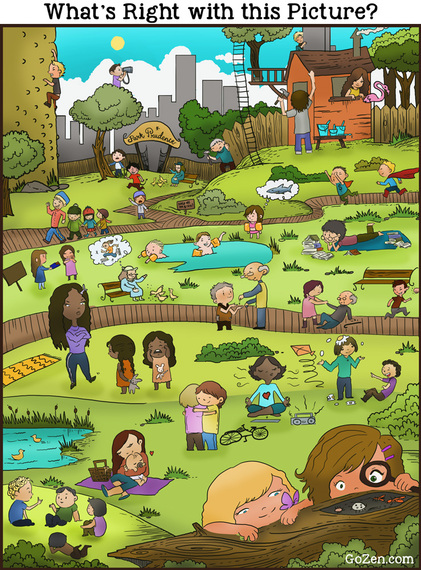Remember Highlights children's magazine -- the one full of fun activities that would often be stacked at the doctor's office? I always grabbed it and flipped to the back cover, which featured a busy, illustrated scene of children playing alongside objects and scenarios that weren't quite logical. You might see an upside-down balloon in the sky or a unicorn riding a bicycle, for example. The suggested activity was to spot all these type of "errors" and was titled, "What's wrong with this picture?"
Detecting things that didn't make sense was pretty simple and, no doubt, fun for both kids and their parents. I also would say it was quite a natural activity. After all, we're hardwired to spot anomalies in our surroundings. Think about cave people who were out hunting and gathering for their families. Those attuned to predators, danger, or anomalies in their environment were more likely to survive. Although we don't regularly have the need to run from predators in modern times, we're left with an evolutionary imprint known as the negativity bias.
In short, negativity bias means that negative events and circumstances weigh more heavily -- psychologically speaking -- than do positive ones. I believe this bias influences how we interact with our children. Often with the best of intentions and great love, we focus on rooting out and fixing weaknesses (e.g., study more, watch less TV, eat better food, etc.) as a path to greater happiness and success for our kids.
Here's the thing: what if minimizing "what's wrong" is only half the equation when it comes to living a good life? What if focusing on "what's right" can be as powerful a path to well-being? What would happen if we shifted our focus to teach kids about their character strengths? Let's take a look at some of the research.
The research on character strengths
- Strengths such as self-regulation, perseverance, and love of learning predict academic success (Weber & Ruch, 2012).
How can we teach kids about character strengths?
There are many different (and fun!) ways to teach kids about character strengths. One place to start is to improve their strength vocabulary (and our own). When we speak, we use the words and phrases that are most accessible to us or that pop into our minds first.
For example, it's more common for parents or teachers to say things such as, "Good job!" or "I'm proud of you!" or "Great going!" than "That was a very creative process you used!" or "Your perseverance when it comes to violin practice is really impressive!" or "You really showed social intelligence in that conversation with your friend!"
To build strength vocabulary, try this fun activity below. You'll see 24 strengths listed below that are part of the VIA Classification of Strengths. Then, look at the activity below and see how many strengths you can see played out.
Activity: What's Right With This Picture?
Appreciation of Beauty and Excellence
Bravery
Creativity
Curiosity
Fairness
Forgiveness
Gratitude
Honesty
Hope
Humility
Humor
Judgment
Kindness
Leadership
Love
Love of Learning
Perseverance
Perspective
Prudence
Self-Regulation
Social Intelligence
Spirituality
Teamwork
Zest
Find as many of the strengths listed above in the image below.
For more activities on teaching character strengths to kids, visit us at www.gostrengths.com.
Also, check out our workbook: What's Right With This Picture?
References:
Gillham, J., Adams-Deutsch, Z., Werner, J., Reivich, K., Coulter-Heindl, V., Linkins, M., Winder, B., Peterson, C., Park, N., Abenavoli, R., Contero, A., & Seligman, M. E. P. (2011). Character strengths predict subjective well-being during adolescence. Journal of Positive Psychology, 6(1), 31-44.
Proctor, C., Tsukayama, E., Wood, A., M., Maltby, J., Fox Eades, J., & Linley, P. A. (2011). Strengths gym: The impact of a character strengths-based intervention on the life satisfaction and well-being of adolescents. Journal of Positive Psychology, 6(5), 377-388.
Seligman, M. E. P., Ernst, R. M., Gillham, J., Reivich, K., & Linkins, M. (2009). Positive education: Positive psychology and classroom interventions. Oxford Review of Education, 35(3), 293-311.
Weber, M., & Ruch, W. (2012b). The role of a good character in 12-year-old school children: Do character strengths matter in the classroom? Child Indicators Research, 5(2), 317-334.
Illustration credit: www.gozen.com
